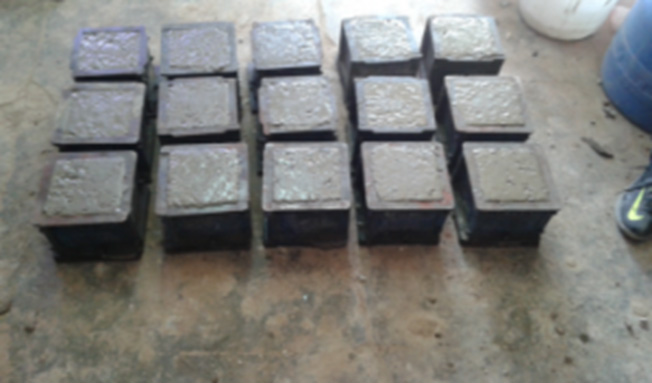
Geopolymer Concrete
Description:
Building Material Category: Admixture
Building Component Type: Wall and Slab
Alternative for Conventional Building Material: Portland Cement in Concrete
Introduction: Geopolymer concrete is a type of alternative concrete that uses geopolymeric binders instead of traditional Portland cement. It's made by activating aluminosilicate materials (such as fly ash, slag, or metakaolin) with an alkaline solution (typically a mix of sodium or potassium hydroxide and sodium or potassium silicate). The result is a concrete that has similar or even superior properties compared to traditional concrete. It has lower thermal conductivity and transmittance as compared to traditional cement concrete, thus enhancing energy efficiency in buildings.
Composition: Typically includes industrial by-products like fly ash or slag, alkali activators (e.g., sodium hydroxide, potassium hydroxide), and aggregates.
Applicability in Climatic Zone: Suitable for all climatic zones in India, depending on specific formulations and local conditions.
Use: It is used as a binder in concrete for various construction applications including foundations, walls, floors, and precast elements.
Thermal Performance: It offers improved thermal insulation properties compared to conventional concrete, reducing heating and cooling loads in buildings.
Thermal Conductivity: Typically ranges from 0.8 to 1.5 W/mK, depending on the mix design and materials used.
Thermal Transmittance: Typical U-values for geopolymer concrete can range from 0.5 to 1.5 W/m²K, depending on the specific mix design, thickness, density, thermal conductivity, and area of application.
Reduction in CO2 Emissions: Geopolymer concrete can significantly reduce CO2 emissions, with potential reductions ranging from 30% to 90% compared to traditional Portland cement concrete. The extent of these reductions depends on factors such as the choice of raw materials, production methods, and overall lifecycle considerations. These reductions contribute to the sustainability of construction practices and help address climate change by lowering the carbon footprint of concrete production.
Salient Features
- Cement Replacement: It substitutes traditional cement with industrial by-products like fly ash and slag, reducing CO2 emissions and promoting waste utilization.
- Energy Efficiency: Geopolymer concrete has a low U-value, minimizing heat transfer through buildings and reducing heating and cooling energy consumption.
- Utilization of Industrial Waste: By incorporating fly ash and slag, it supports sustainability by diverting waste from landfills and conserving natural resources.
- Durability and Performance: It offers high compressive strength, durability against chemical attack, and resistance to abrasion and corrosion, ensuring long-term performance with minimal maintenance.
- Sustainable Building Practices: Geopolymer concrete aligns with green building certifications like LEED and BREEAM, emphasizing its environmental benefits and use of recycled materials.
- Ongoing Innovation: Research continues to enhance geopolymer concrete’s properties and expand its applications, driving advancements in sustainable construction practices.
Indian Codes for Geopolymer Concrete
As of now, specific Indian codes exclusively for geopolymer concrete are not fully developed. However, several existing codes and standards are relevant for understanding and adapting geopolymer concrete practices:
- IS 456:2000 - Code of Practice for Plain and Reinforced Concrete: General guidelines for concrete, which may be adapted for geopolymer concrete.
- IS 383:2016 - Specification for Coarse and Fine Aggregates from Natural Sources for Concrete: Provides specifications for aggregates used in concrete, applicable to geopolymer concrete aggregates.
- IS 9103:1999 - Specification for Admixtures for Concrete: Guidelines for chemical admixtures, which may be relevant for geopolymer concrete.
- IS 13920:2016 - Ductile Detailing of Reinforced Concrete Structures Subjected to Seismic Forces: Guidelines for seismic detailing, relevant for structures using geopolymer concrete.
- National Building Code (NBC) of India: Provides overall guidelines for building practices and materials, including considerations that can be adapted for new materials like geopolymer concrete.
International Codes for Geopolymer Concrete
International standards provide more comprehensive guidelines and are often used in conjunction with local codes:
- ASTM C 1157/C 1157M - Standard Performance Specification for Hydraulic Cement: Provides performance criteria for hydraulic cements, including geopolymers.
- ISO 22965 - Part of the ISO 22965 series on hydraulic cements, including geopolymers: Developing standards addressing geopolymer concrete properties, testing methods, and durability.
- ACI 548.1R - Guide for the Use of Polymers in Concrete: While primarily focused on polymers, it provides insights into advanced concrete technologies that can be relevant for geopolymers.
- BS 8500 - Concrete – Complementary British Standard to EN 206: Provides guidelines for concrete specifications that can be adapted for geopolymer concrete.
- EN 197-1 - Cement – Composition, Specifications, and Conformity Criteria: Addresses hydraulic cements, including those used in geopolymer concrete.
For geopolymer concrete, while specific Indian codes are still evolving, existing codes provide foundational guidance. International standards offer more detailed protocols and are often referenced to fill gaps in local regulations. Staying updated with ongoing developments in both Indian and international standards are essential for ensuring the effective and compliant use of geopolymer concrete in construction projects.
Manufacturers
In India, several companies are involved in the production and supply of geopolymer concrete and related materials. These companies are often engaged in research, development, and commercial applications of geopolymer technology. Here’s a list of notable manufacturers and suppliers of geopolymer concrete in India:
- Cemex India: Known for innovative building materials, Cemex India has been involved in the research and development of geopolymer concrete. Website: Cemex India
- BASF India: While primarily a chemical company, BASF India is involved in producing advanced construction materials, including geopolymer concrete solutions. Website: BASF India
- UltraTech Cement: UltraTech is one of the leading cement manufacturers in India and has been exploring advanced concrete technologies, including geopolymer concrete. Website: UltraTech Cement
- Indian Concrete Institute (ICI): While not a manufacturer, ICI is a key industry body that promotes research and development in concrete technology, including geopolymers. They often collaborate with manufacturers and researchers. Website: Indian Concrete Institute
Sources: